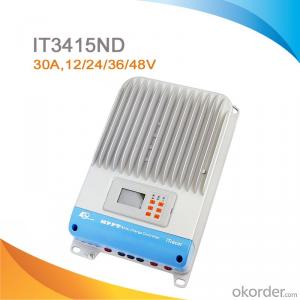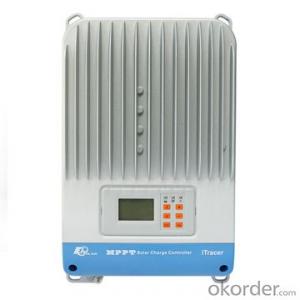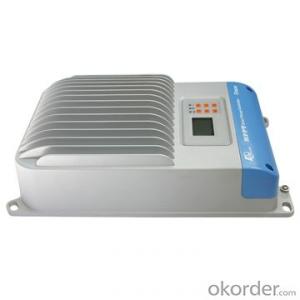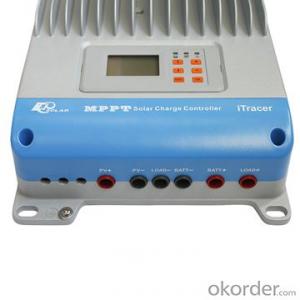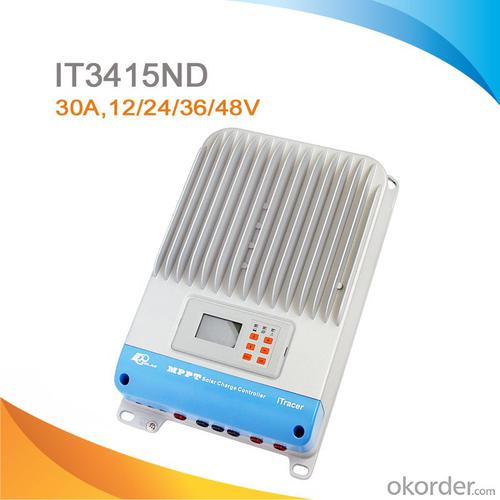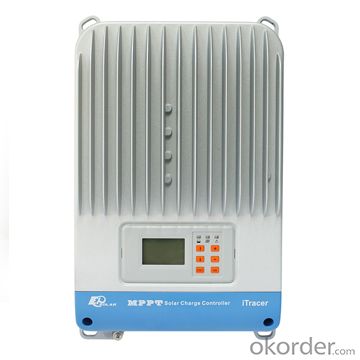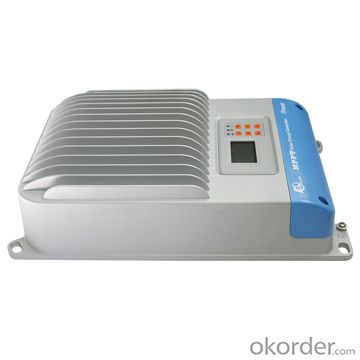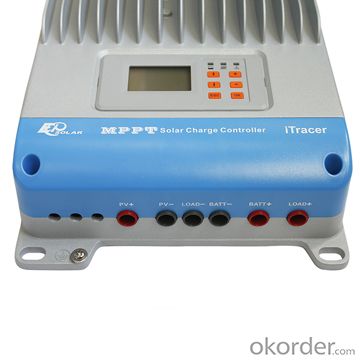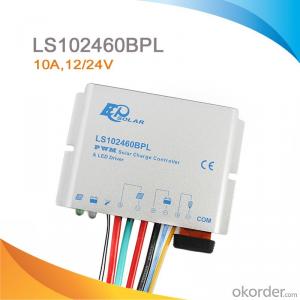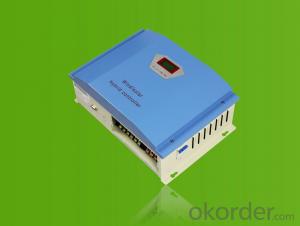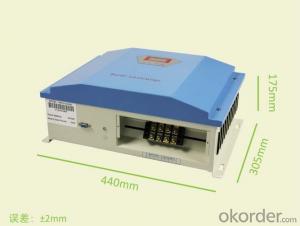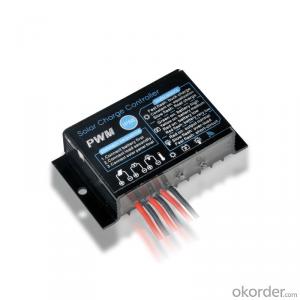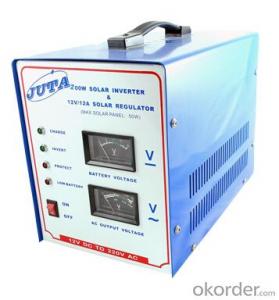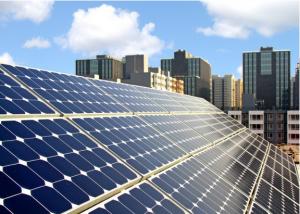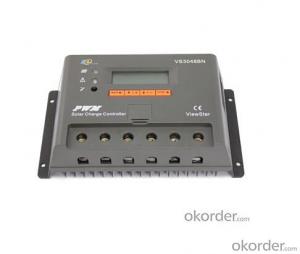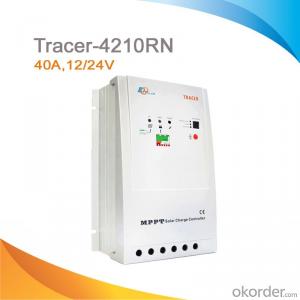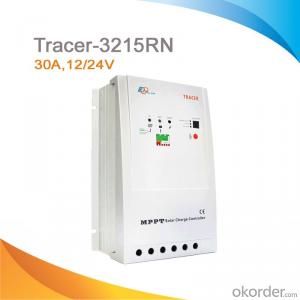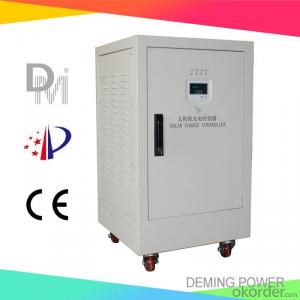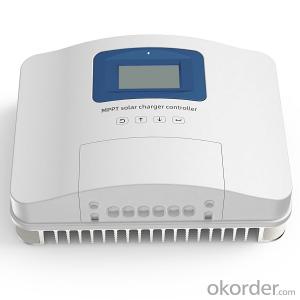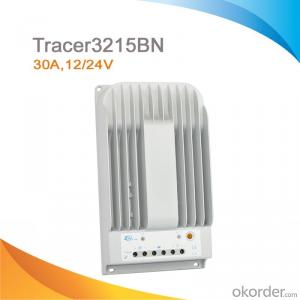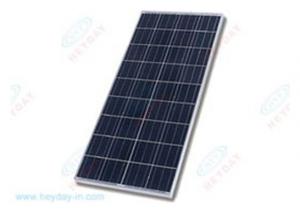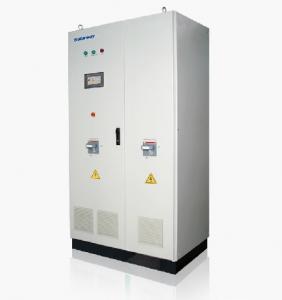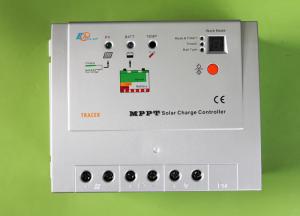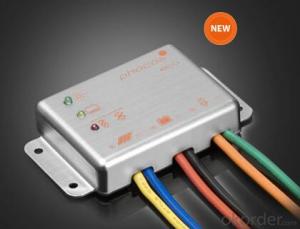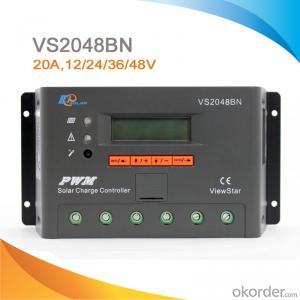iTracer Series MPPT Solar Charge Controller/Solar Battery Charge Regulator for Solar Power System
- Loading Port:
- Tianjin
- Payment Terms:
- TT or LC
- Min Order Qty:
- 30 watt
- Supply Capability:
- 10000 watt/month
OKorder Service Pledge
OKorder Financial Service
You Might Also Like
iTracer is an industrial grade product with advanced Maximum Power Point Tracking (MPPT) algorithm. It can deliver the maximum available power for charging batteries and charge a lower nominal voltage battery from a higher nominal voltage array.
Features:
• Advanced MPPT algorithm with the max. tracking efficiency of 99%
• Multi-phase synchronous rectification technology realizing peak conversion efficiency 98%
• Dual-core(ARM CPU+DSP) control architecture improves the system response speed and optimizes the performance of the system
• Multiphase control technology, optimizes charging current smoothness, reduces ripple and improves the system efficiency
• 128*64 dot-matrix LCD intuitively displays data and state, 6 buttons combinations for easy operation
• Four battery type options: Sealed, Gel, Flooded and User-defined
• Energy statistics recording, it is convenient for users to view charging and discharging energy of each day, month, year and total value.
• Diversified load control mode
• Programmable battery management parameters
• Built-in running data and event logging, max. 15 months
• Extensive communication capabilities (RS232,RS485 with Modbus protocol, CAN Bus extendable)
• PC software available for real time monitoring and parameter setting
• Field upgradable firmware
Electronic Protections:
• PV short circuit protection
• PV overvoltage protection
• PV over current protection
• PV reverse polarity protection
• Reverse current protection at night
• Over temperature protection
• Battery reverse polarity protection
• Load overload protection
• Load short circuit protection
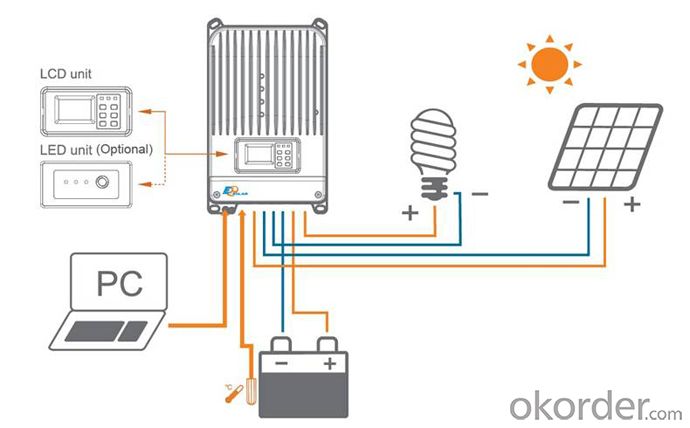
Specification:
Model | IT3415ND | IT4415ND | IT6415ND |
Rated system voltage | 12V/24V /36V/48V auto work | ||
Rated battery current | 30A | 45A | 60A |
Rated load current | 30A | 45A | 60A |
Max. PV open circuit voltage | 150V | ||
Voltage range | 8~72V | ||
Max.PV input power | 400W (12V) | 600W (12V) | 800W (12V) |
800W (24V) | 1200W (24V) | 1600W (24V) | |
1200W (36V) | 1800W (36V) | 2400W (36V) | |
1600W (48V) | 2400W (48V) | 3200W (48V) | |
Self-consumption | 1.4~2.2W | ||
Equalize charging voltage | Sealed: 14.6V, Flooded: 14.8V, User-defined: 9~17V | ||
Boost charging voltage | Gel: 14.2V, Sealed: 14.4V, Flooded: 14.6V, User-defined: 9~17V | ||
Float charging voltage | Gel /Sealed /Flooded: 13.8V, User-defined: 9~17V | ||
Low voltage reconnect voltage | Gel /Sealed /Flooded: 12.6V, User-defined: 9~17V | ||
Low voltage disconnect voltage | Gel /Sealed /Flooded: 11.1V, User-defined: 9~17V | ||
Grounding | Common negative | ||
Tracking efficiency | 99% | ||
Peak conversion efficiency | 98% | ||
Dimension | 358x219x102mm | 382x231x107mm | 440x231x110mm |
Terminal | 25mm2 | 35mm2 | 35mm2 |
Net Weight | 3.7kg | 4.6kg | 5.9kg |
Working temperature | -25℃~+55℃ | ||
Storage temperature range | -30℃~+85℃ | ||
Humidity | 95% NC | ||
Enclosure | IP20 | ||
FAQ:
Q1. What is the voltage?
A1. Our 45/60A solar charge controller is 12/24/36/48V auto work.
Q2. What is the difference between MPPT&PWM?
A2. MPPT has higher efficiency, it can track the max power point and won't waste energy.
Q3. What is the efficiency of the MPPT controller?
A3. MPPT>99%, peak conversion efficiency>98%.
Q4. What is the waranty of product?
A4. 12 months.
Q5. What protection does your MPPT controller have?
A5. PV array short circuit, PV reverse polarity, Battery reverse polarity, Over charging, Output short circuit.
- Q: Can a solar controller be used in extreme weather conditions?
- Yes, a solar controller can be used in extreme weather conditions. Most solar controllers are designed to withstand a wide range of weather conditions, including extreme temperatures, high humidity, and even heavy rain or snow. However, it is important to choose a high-quality controller that is specifically designed for outdoor use and can handle the specific weather conditions in your location.
- Q: Can a solar controller be used with multiple solar panels?
- Yes, a solar controller can be used with multiple solar panels. The solar controller is responsible for regulating the flow of electricity between the solar panels and the battery or grid, regardless of the number of panels connected to it. It ensures that the panels are functioning optimally and prevents overcharging or damage to the system.
- Q: Can a solar controller be used with solar-powered drones?
- Yes, a solar controller can be used with solar-powered drones. A solar controller is an essential component of a solar power system that manages the flow of electricity from the solar panels to the battery. In the case of solar-powered drones, the solar controller would regulate the charging of the drone's battery using the energy generated by the solar panels. This ensures that the battery is charged efficiently and prevents overcharging or damage to the battery. Furthermore, the solar controller can also provide important monitoring and protection functions, such as temperature compensation and over-discharge prevention, which are crucial for the safe and optimal operation of the drone. Overall, a solar controller is a valuable tool for integrating solar power into drone systems, enabling longer flight times and more sustainable operations.
- Q: How does a solar controller handle high current flow from the solar panels?
- A solar controller, also known as a charge controller, plays a crucial role in regulating the flow of current from the solar panels to the battery bank. It ensures that the batteries receive the correct amount of charge and prevents overcharging or damage to the batteries. When high current flows from the solar panels, the solar controller manages this by utilizing a few key mechanisms. Firstly, it employs a pulse width modulation (PWM) or maximum power point tracking (MPPT) technique to efficiently convert the high current generated by the solar panels into the appropriate voltage and current required for charging the batteries. In the case of a PWM controller, it rapidly switches the connection between the solar panels and the battery bank on and off, controlling the flow of current and voltage to match the battery's requirements. This method effectively regulates the charging process and prevents excessive current from reaching the batteries. On the other hand, MPPT controllers employ advanced algorithms and circuitry to track the maximum power point of the solar panels, optimizing the energy conversion process. These controllers can handle high current flow by adjusting the voltage and current to maintain the maximum power output from the panels, resulting in more efficient charging of the batteries. Additionally, solar controllers incorporate various safety features to handle high current flow. They typically have built-in protections such as overcharge protection, short-circuit protection, and reverse polarity protection. These safeguards ensure the system remains safe and prevents any damage to the solar panels, batteries, or other connected components. In summary, a solar controller effectively handles high current flow from the solar panels through techniques such as PWM or MPPT, optimizing the energy conversion process. It also incorporates safety features to protect the system and ensure the batteries receive the appropriate charge without any risk of damage.
- Q: Can a solar controller be used in conjunction with a power inverter?
- When used together, a solar controller and a power inverter can optimize the charging of a battery from a solar panel while converting the stored DC power into AC power for household appliances or electrical devices. This combination enhances the efficiency and reliability of the system by ensuring optimal battery charging through the solar controller and providing necessary AC power through the power inverter. To guarantee compatibility, it is crucial to verify the suitability of the solar controller and power inverter for each other. Further, following proper installation and wiring procedures is essential to ensure safe and effective system operation.
- Q: Can a solar controller handle power fluctuations from appliances?
- Yes, a solar controller is designed to handle power fluctuations from appliances. It regulates the flow of power from the solar panels to the appliances, ensuring a stable and consistent supply of electricity.
- Q: Is it possible to connect multiple solar controllers together?
- Yes, it is possible to connect multiple solar controllers together. This can be done by connecting the outputs of each solar controller in parallel, which allows them to work together to charge a common battery bank. However, it is important to ensure that the combined capacity of the solar controllers does not exceed the maximum charging capacity of the battery bank. Additionally, proper wiring and sizing of cables should be followed to minimize voltage drop and ensure efficient operation. It is also advisable to consult the manufacturer's guidelines and specifications to ensure compatibility and avoid any potential issues.
- Q: What is the role of a solar controller in preventing electrical surges in the solar panel system?
- The role of a solar controller in preventing electrical surges in the solar panel system is to regulate and control the flow of electricity between the solar panels and the batteries or the grid. It ensures that the voltage and current levels are kept within safe limits, preventing any sudden spikes or surges that may damage the system components. The solar controller also provides protection against overcharging or over-discharging of batteries, safeguarding the overall system from potential electrical surges.
- Q: Can a solar controller be used with a solar-powered water desalination system?
- Yes, a solar controller can be used with a solar-powered water desalination system. A solar controller is designed to regulate and optimize the charging of batteries from solar panels. In a solar-powered water desalination system, solar panels generate electricity to power the system and charge the batteries. The solar controller ensures that the batteries are charged efficiently and protects them from overcharging, thus enhancing the overall performance and longevity of the system.
- Q: Are there any efficiency differences between PWM and MPPT solar controllers?
- PWM and MPPT solar controllers have efficiency differences. Compared to MPPT controllers, PWM controllers have a simpler design and are generally less expensive. However, they are less efficient at converting the solar panel's output to the battery's charging voltage. PWM controllers achieve voltage regulation by rapidly turning the solar panel's output on and off, resulting in a square wave output. This can lead to some energy loss because the solar panel's output voltage is not always perfectly matched to the battery's charging voltage. On the other hand, MPPT controllers utilize advanced algorithms to constantly adjust the solar panel's output voltage and current. This allows them to find the maximum power point, where the panel operates at its highest efficiency. By dynamically adjusting the charging voltage and current, MPPT controllers can extract more power from the solar panel and deliver it to the battery, resulting in overall higher system efficiency. MPPT controllers are especially advantageous when the solar panel's voltage is significantly higher than the battery's charging voltage. In such cases, using PWM controllers would result in substantial energy loss, while MPPT controllers can efficiently convert the higher voltage to the battery's required voltage. In summary, while PWM controllers are simpler and more affordable, MPPT controllers offer greater efficiency in converting solar energy to battery charging voltage. The choice between the two depends on factors such as cost, system design, and the specific requirements of the solar power system.
Send your message to us
iTracer Series MPPT Solar Charge Controller/Solar Battery Charge Regulator for Solar Power System
- Loading Port:
- Tianjin
- Payment Terms:
- TT or LC
- Min Order Qty:
- 30 watt
- Supply Capability:
- 10000 watt/month
OKorder Service Pledge
OKorder Financial Service
Similar products
Hot products
Hot Searches
Related keywords
